Excerpts from Jim Conrad's
Naturalist Newsletter
entry dated April 6, 2023, with notes from the lower slope of hill south of El Cerrito, 5kms south of Tequisquiapan; bedrock volcanic andesite, an intermediate rock between basalt and rhyolite; elevation about 2,000m (6600 ft), Querétaro state, MÉXICO
(~N20.47°, ~W99.89°)
MEXICAN PINCUSHION
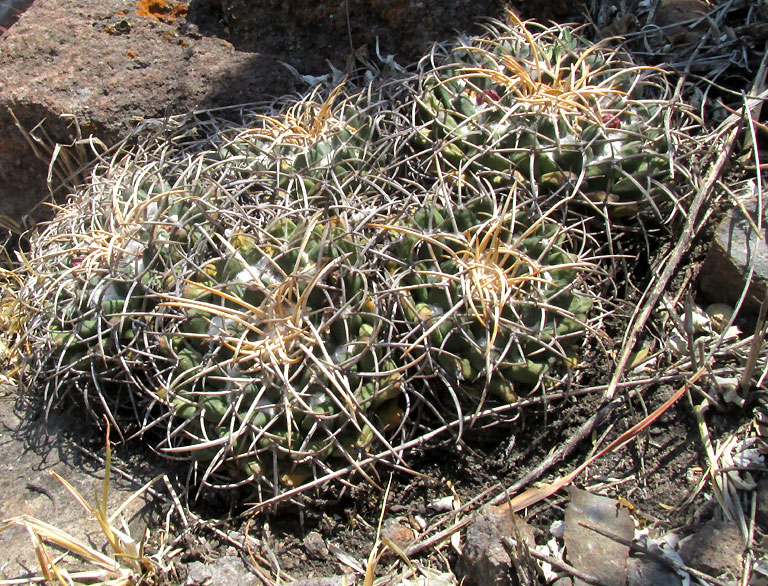
On a grossly overgrazed, eroded lower slope of the ridge south of El Cerrito, the above colony of spherical cacti grew among volcanic rocks beneath the low hanging, spiny branches of a protective mesquite, Prosopis laevigata. The cacti bore neither flowers nor fruits, and in this cactus-rich region, that means that identification can be challenging. However, even at a distance important field marks could be seen: the spherical bodies; fairly long, thick and curved spines densely mantling the body, and; the body's surface manifests as spirals of low mounds, or "tubercles."

Above, it's seen that between tubercles atop each cactus, but not lower down, masses of white, cottony hairs gather. Also, atop each tubercle, there's a cluster of typically four or five spreading spines. Among spherical, tuberculate cactus species, an important field mark to notice is whether the tubercles bear a groove cut into each tubercle's side. Beehive cacti of the big genus Coryphantha display such a groove, but mammillaria cacti of the similarly large genus Mammillaria don't. It's hard to say whether this cactus's tubercles are cleaved with grooves. Most tubercles appear to lack them, but some show shallow in-folds that could be grooves. However, the kinds of grooves we're looking for are definite, narrow, straight, incision-like ones on each tubercle. In the picture, what appear as possible grooves must be puckering and wrinkling resulted from the severe dry season currently taking place.
At this point, noting that we have spherical cactus bodies fractured into tubercles without grooves, if we prick the body's surface and the wound bleeds a watery or milky latex, already we know we have a member of the big genus Mammillaria. According to the current GBIF Mammillaria page, that genus comprises 449 accepted species. The Flora del Bajío treatment of Mammillaria of our region documents 41 species in our upland area of central Mexico.
The matter of tubercle grooves isn't the only issue that can confuse us with this species in the field. Also it can be little hard to interpret the spines:
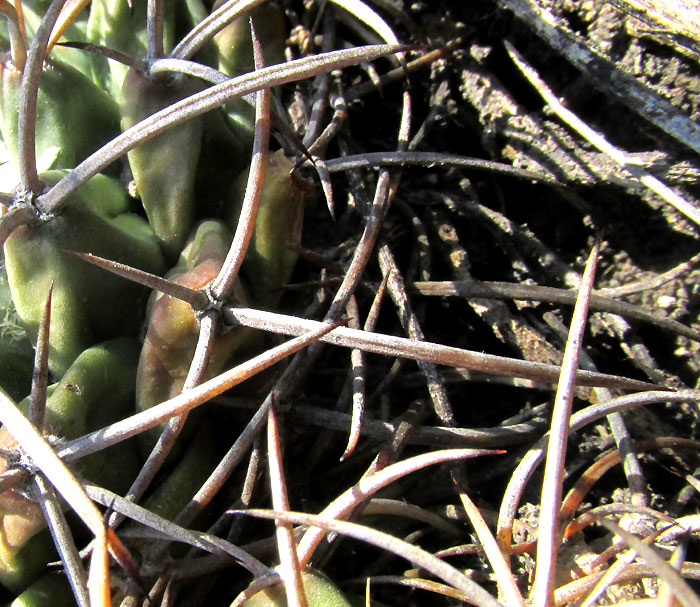
The above close-up frames a single cross-shaped cluster (lying on its side) of four thick, curved spines, which overlap spines arising atop surrounding tubercles. Among Mammillaria species, such clusters often produce two spine types: "radial" spines radiating from the cluster's base, keeping somewhat parallel with the body's surface, and; "central" spines, arising in the cluster's center and pointing away from the cactus body. Often species bear several to many radial spines, but just a single central spine. So, what do we have here? If you're "keying out" the species using technical descriptions, you can go astray here, for the key may insist that this species only bears radial spines on its younger bodies, while on mature cacti like ours there are none. But are the spines shown above central ones projecting outward, or are they radiating somewhat horizontally? They're half-way between. The experts assert that our spines are central, the radial ones having falling off.
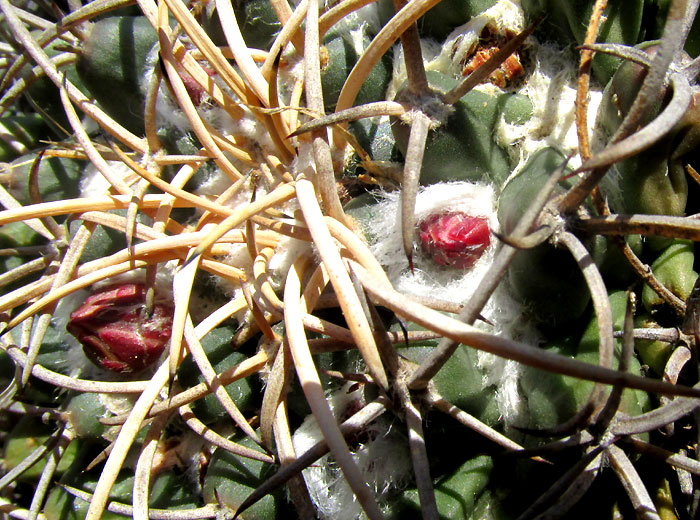
Our plants bear no flowers, but they do produce flower buds, of which two reddish ones appear above. Note that the buds arise between tubercles, not atop individual tubercles. That's another good field mark for the mammillarias. Also, in the above picture, the very tip-top of the globe-shaped body is located above and somewhat between the two flowers. It's where both cottony hairs and spine density are most apparent. The detail to register is that flowers from the buds will not blossom exactly at the body's top, but rather a little below the top. They'll form a garland of small flowers encircling the cactus's crown, and that's another feature pointing to the mammillarias.
All the above observations lead us to MAMMILLARIA MAGNIMAMMA, sometimes known in English as the Mexican Pincushion. Despite the species being endemic just to upland central Mexico, it warrants an English name because it's sold commercially. In England it's been awarded the Royal Horticultural Society's Award of Garden Merit. TheSucculence.Com currently sells two-inch tall, potted Mammillaria magnimamma plants for $20.00, describing the species as easy to care for, just give it plenty of sunlight.
Within its small distribution area, Mammillaria magnimamma is regarded as commonly occurring in a variety of habitats, from pine, juniper and tropical deciduous forests to arid grasslands.
A 2021 study by Alejandro Franco Uriostegui and others entitled "Importancia de Mammillaria magnimamma (Cactaceae) como fuente de recursos para su comunidad de hormigas asociadas, en el Valle del Mezquital, Hidalgo," looked at ant use of Mammillaria magnimamma. During the proper seasons, nine ant species were found habitually to collect our cactus's flower buds, nectar, pollen, stamens, tepals, fruits, seeds, and woolly hairs. Three more ant species were considered occasional visitors.
If only because ants play such an important roll in community ecology, our ant-supporting Mammillaria magnimamma can be described as an important member of the ecosystem of our scrubby lower slope.
A SECOND PLANT: Later in the day, maybe 100m away, on the same slope, a second cluster turned up in a rocker situation more exposed to sunlight:

The general appearance of these cacti was different because the spines were shorter and the green tubercles were much more visible. In this population, a flower bud was more advanced:
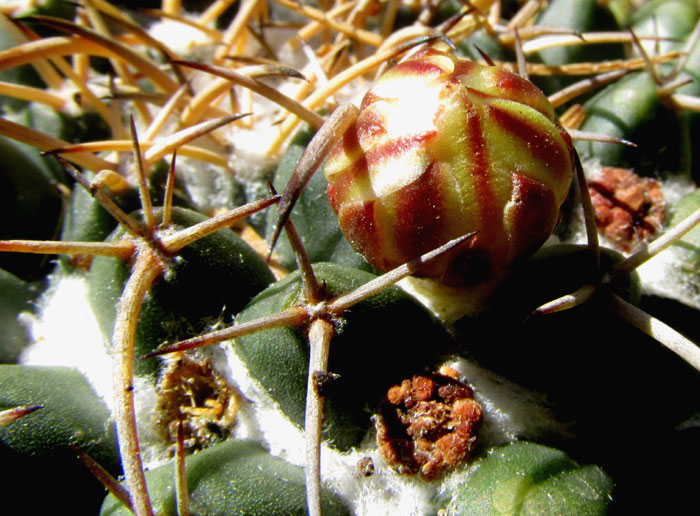
These cacti appeared less drought stressed than the previous ones, for their tubercles weren't as wrinkled. Above it's easier to see that the tubercles have no groove. The brown, crumbly-looking items amid cottony hairs below the bud appear to be younger flower buds.
Entry dated March 9, 2024, from notes taken about 2kms west of Higuerillas, Municipality of Cadereyta de Montes; N20.9086°, W99.7865°, elevation ~1760 meters (~5760 feet); on greywacke sandstone cap of hill; area constituting a narrow belt of the extreme southern extension of the Chihuahuan Desert, Meridional Subregion; central Querétaro state, MÉXICO
#3, WITH FINGERS
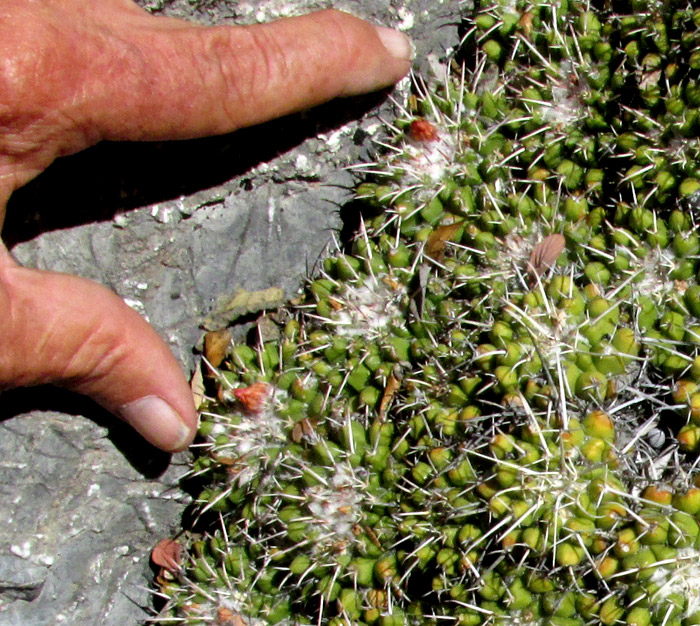
Another population, this time shown with fingers for scale, indicating that the heads are relatively small.